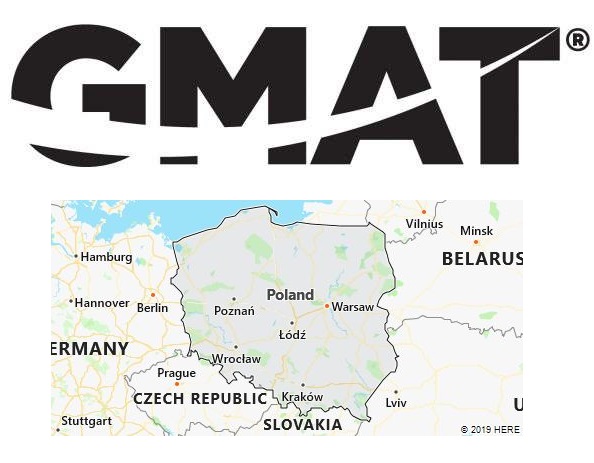GMAT Testing Location
We have found 1 GMAT test centre in Poland, located in Warszawa. For specific test dates of 2019, please refer to the end of this page.

BBIA
ul. Ostrobramska 101A
04-041 Warszawa
Poland
Phone: +48-224724044
Test Center Information
Uwaga kandydaci z Polski!
Wiekszosc egzaminow (m.in. UKCAT, LNAT, (ISC)2, GMAT, GED …) wymaga przedlozenia dokumentu tozsamosci zawierajacego podpis – nowa wersja polskiego dowodu osobistego nie zawiera podpisu i z tego powodu nie jest on wystarczajacy do potwierdzenie tozsamosci kandydata. W takiej sytuacji nalezy przedstawic podczas rejestracji prawo jazdy albo paszport lub skontaktowac sie instytucja certyfikujaca z wnioskiem o dopuszczenie z korzystania z dowodu tozsamosci, ktory nie zawiera podpisu.
Lokalizacja:
Firma bbia Sp. z o.o. znajduje sie przy ulicy Ostrobramskiej 101A. Centrum egzaminacyjne znajduje sie na parterze, w glownym holu obok banku PeKaO SA.
Dojazd komunikacja miejska:
Dojazd autobusami linii 135, 311, 151, 158, 182, 514, 502, 520, 525 – przystanek POLIGONOWA (dawniej RAWAR).
Z Dworca Centralnego najlatwiej dostac sie autobusem 525 przystanek przy Zlotych Tarasach, dojazd trwa okolo 25 minut, lub autobusem 158 (przystanek przed hotelem Marriott)
Z Dworca Zachodniego dojazd jest bezposrednio autobusem linii 158, 182 – czas dojazdu wynosi ok. 40 minut.
Ze stacji Metro Stadion Narodowy – dojazd autobusem 135 – czas dojazdu wynosi ok. 20 minut.
Ze stacji Metro Politechnika – dojazd autobusami: 151, 182, 514, 502, 520, 525 – czas dojazdu wynosi ok. 15 minut.
Uwaga – nie zapewniamy na terenie biurowca miejsc parkingowych.
W przypadku pytan prosimy o kontakt pod numerem telefonu: +48-224724044.
——————————————————————————————————————————
Location:
bbia Sp. z o.o. is located in Ostrobramska 101A Street on the ground floor next to PeKaO bank.
How to get to bbia public transport:
You can get here by the following buses: 135, 311, 151, 158, 182, 514, 502, 520, 525, the bus stop is called POLIGONOWA (former RAWAR).
From the Central Railway Station (Warszawa Centralna) – take the bus 525 (about 25 minutes directly), or bus 158 (bus stop in front of hotel Mariott).
From the West Railway Station (Warszawa Zachodnia) – take the bus 182 or 158 (about 40 minutes directly).
From station Metro National Stadion (Metro Stadion Narodowy) – bus 135 (about 20 minutes directly).
From station Metro Politechnika – buses 151, 182, 514, 502, 520, 525 (about 15 minutes directly).
We do not provide any parking space nearby our test center building.
In case of further question please contact us: +48-224724044 or info@bbia.pl.
GMAT Exam Dates in Poland
Unlike some paper based exams, the GMAT is computer based. Therefore, there are no fixed test dates for GMAT. Wherever you are in Poland, all test centers are open from Monday through Saturday throughout the year. Some even offer the exam every day of the year. However, some test centers are not open on Sundays and national holidays. For example, most college-based test centers might be closed for extended periods around holidays. For precise testing dates in Poland, please visit test-maker website – https://www.mba.com/.
More about Poland
History
West Slavic Polans immigrated to the area from the 6th century. At the end of the 10th century, the Poles adopted Christianity. From 1226 the Teutonic Order settled. From 1386 to 1569 the independent empires of Poland and Lithuania were united under a common monarch (personal union). Poland experienced its first heyday. In 1410 it submitted to the Teutonic Order. From the 14th century onwards, numerous Jews from Western Europe, where they were persecuted, moved to Poland. Under the increasing influence of wealthy aristocratic families, Poland became an elective monarchy in 1572. In the period that followed, the Polish throne was often occupied by foreign princes.
The progressive Russian interference and the aristocratic parties that fell out in a civil war resulted in the first partition of Poland. Poland lost about a quarter of its territory to Prussia, Russia and Austria. Revolts by the Poles against the partitioning powers were suppressed and the second (1793) and third division (1795) followed. With that the country had lost its independence.
It was not until 1918, after the First World War, that Poland became a separate state again. On September 1, 1939, German troops marched into Poland and the Second World War began. The Poles suffered great suffering during the war. The German occupation forces transported the Polish Jews to labor and extermination camps such as Auschwitz and Majdanek. A total of around six million Poles, half of them Jews, lost their lives. After the war, Poland was ceded to the Soviet Union with former German territories east of the Oder-Neisse linecompensated. Millions of Germans were expelled from Poland. From 1952-89 Poland was a People’s Republic and was ruled by the Communist Party of Poland. The Soviet Union had great political and economic influence.
The quest for more democracy and economic decline led to the establishment of the independent trade union Solidarność in 1980, chaired by L. Wałęsa. Although party and government leader Wojciech Jaruzelski (* 1923, † 2014) imposed martial law, democratization could no longer be stopped. In 1990 the country was renamed the Republic of Poland. In 1991 the first free parliamentary elections took place. In 1997 a new constitution came into force. Poland has been a member of NATO since 1999. In 2004 Poland joined the European Union.
